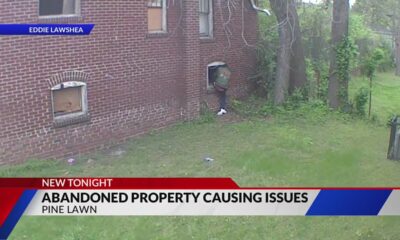Mississippi News
Greenhouse gas: Petal plant emits half ton of methane hourly

Every hour, this gas storage station sends half a ton of methane into the atmosphere
PETAL —The Petal Gas Storage Station lies halfway between the winding banks of the Leaf River and the International Checker Hall of Fame. It’s a warren of pipes, wellheads and metal buildings where noisy compressors pump gas underground and then suck it back up to the surface again.
In the process, the Petal plant releases half a ton of a potent greenhouse gas into the atmosphere every hour—more than any other gas storage facility in the country.
Petal is one of hundreds of underground natural gas storage facilities across the United States, where operators pump gas into underground salt formations, aquifers or depleted oil and gas reservoirs, storing the gas until it is needed.
Underneath the Petal plant lies a vast dome of salt nearly two miles in diameter that formed millions of years ago, during the Mesozoic Era, when other layers of rock pushed down on the surrounding salt formation until it was squeezed upwards into a bulging dome.
A gas company began hollowing out the Petal Dome, creating the nation’s first salt cavity specifically designed for natural gas storage in 1951. Today, eight artificial caverns carved into the Petal Dome store up to 30 billion cubic feet of natural gas, fuel that provides a critical backstop for the region’s fluctuating energy needs.
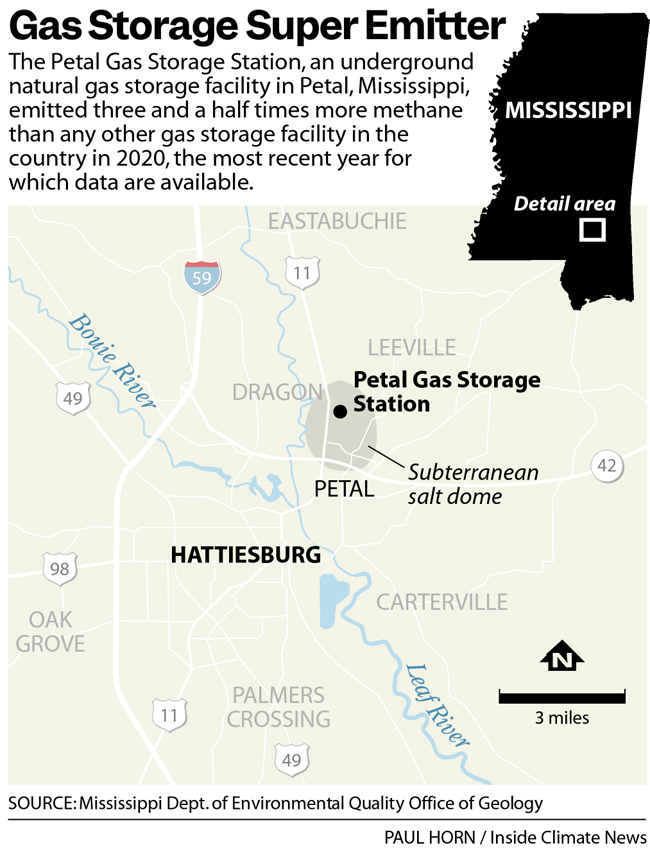
The Petal storage plant is relatively small as gas storage facilities go: It ranks as the 41st largest underground gas storage facility in the country. However, its emissions of methane, the primary component of natural gas, are far and away the highest of all such facilities in the nation.
In 2020, Petal emitted 4,947 metric tons of methane, according to reports submitted by the facility’s owner, Gulf South Pipeline, and its parent company, Boardwalk Pipeline Partners, to the U.S. Environmental Protection Agency. The emissions were three-and-a-half times higher than the methane released that year from any other U.S. gas storage facility.
The Petal facility has held onto the dubious distinction of being the largest such methane emitter for each of the last five years, according to data the companies have submitted to the EPA. In 2020, three of the seven highest emitting gas storage facilities in the country were owned by Boardwalk and its subsidiaries.
Gulf South and Boardwalk have begun to curb emissions at the Petal facility, cutting them in 2020 by nearly 50 percent of what they were in 2019, a year when Petal’s emissions were more than five times larger than any other underground gas storage facility in the country. Boardwalk executives said they slashed emissions again, this time by 54 percent, in 2021.
The EPA has not yet verified Petal’s 2021 emissions. If they are correct, Petal would still be the largest methane emitter among gas storage facilities in the country when compared to the most current available data for all the others.
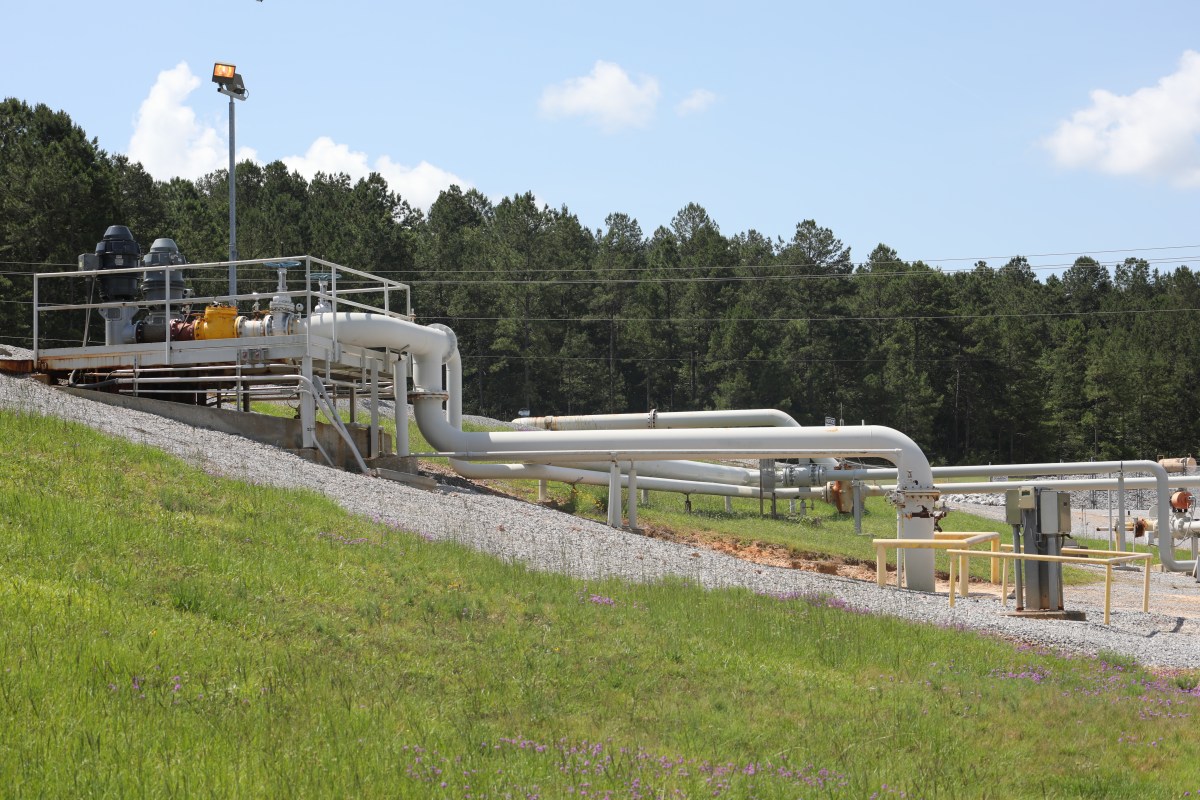
The emissions are especially concerning because methane is an incredibly potent greenhouse gas that, unlike carbon dioxide, has an impact on climate change that is most acute in the years immediately following its release. Methane is 81 times more potent in warming the climate than carbon dioxide over a 20-year period.
Over a 20-year time frame, emissions from the Petal storage station equal the annual greenhouse gas emissions of 87,000 automobiles, more vehicles than the population of Petal and its neighbor Hattiesburg combined.
The Petal facility’s emissions do not violate any state or federal laws, but they call into question the ability of the oil and gas industry to voluntarily curb its own climate pollution.
Emissions from the transmission and storage sector account for approximately 25 percent of the total methane emissions from the natural gas industry. A draft rule proposed by the EPA last November includes what would be the first mandatory methane emission reductions for existing gas transmission and storage facilities.
An environmental assessment by the Federal Energy Regulatory Commission for an expansion of one of the Petal compressor stations noted in 2019 that methane is not toxic, and that the compressors are not within 1,000 feet of any residences.
But leading health organizations, including the American Lung Association, the American Academy of Pediatrics and Physicians for Social Responsibility, wrote to EPA Administrator Michael Regan in July 2021, urging more stringent measures to reduce methane emissions from oil and gas operations.
“Extraction, processing, transport and distribution of methane all contribute to emissions, both of methane and of accompanying pollution like volatile organic compounds (VOCs) and toxic gases,” the letter said. “These emissions pose serious threats to human health, directly as in the case of exposure to toxic gases as well as the smog formed from VOCs, and due to methane’s contribution to climate change.”
In January, after the EPA published its proposed rule change that would impose stricter standards, dozens of Black church leaders in Mississippi wrote to Regan in support of the proposed regulation, noting that their communities are heavily affected by natural gas facilities. They called the proposed regulation an “important step forward.”
Gerald Steele, an alderman in Petal whose ward includes the gas storage site, expressed surprise that the Petal plant’s emissions were the highest from such facilities in the nation. He said that the company is an important financial contributor to the city through its employment and tax contributions. But the news about the emissions, he said, was “really alarming.”
The EPA has historically sought to partner with oil and gas companies through the Natural Gas STAR program to help the companies voluntarily reduce their emissions. An EPA and industry report published in 2006 showed how a facility like Petal could reduce compressor emissions by more than 90 percent. The capital costs for such fixes were so low—several thousand dollars per compressor—that operators could recoup their costs in as little as a month through reductions in the loss of valuable natural gas.
Boardwalk did not respond to an inquiry about the Gas STAR report. Although the company has begun to reduce its emissions, EPA documents suggest that as of 2020, the most recent year for which data is available, they had not followed recommendations made in the report.
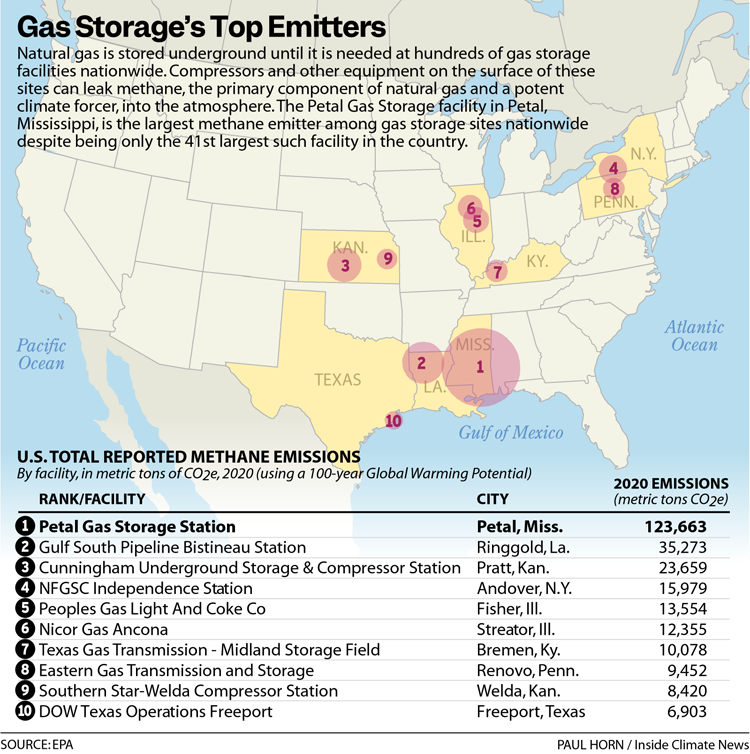
Simple economics make the facility’s outsized emissions perplexing: Natural gas released from the Petal storage facility had a wholesale value of approximately $500,000 in 2020. That would seem to represent a needless annual loss in revenue for either Boardwalk or its customers.
Boardwalk and Gulf South are gas transportation and storage service providers. They don’t buy and sell natural gas, but store it and transport it for others, an arrangement that could reduce some of Boardwalk’s incentive to fix leaks.
“My guess is Boardwalk Pipeline [Partners] does have financial incentives to prevent leakage because they would be liable for losing their customers’ gas, although contracts often include a permitted amount of gas lost in transportation and storage,” David Lyon, a senior scientist with the Environmental Defense Fund, said.
Boardwalk said Gulf South’s terms for lost gas can be found in a gas tariff document held by the Federal Energy Regulatory Commission. However, as this article went to press, it wasn’t immediately clear which document they were referring to.
Lyon, who spends his days pouring over emissions data and researching technologies and policies to reduce leaks from the natural gas industry, seemed baffled by why a company like Boardwalk would not have implemented such effective, low-cost fixes years ago.
“It doesn’t make sense,” he said.
Daniel Zimmerle, the director of the Methane Emissions Technology Evaluation Center at Colorado State University in Fort Collins, is an expert at quantifying and finding ways to reduce emissions from oil and gas operations similar to the Petal facility. But he, too, said he had no explanation for the facility’s high methane emissions.
“It just seems really unusual,” Zimmerle said.
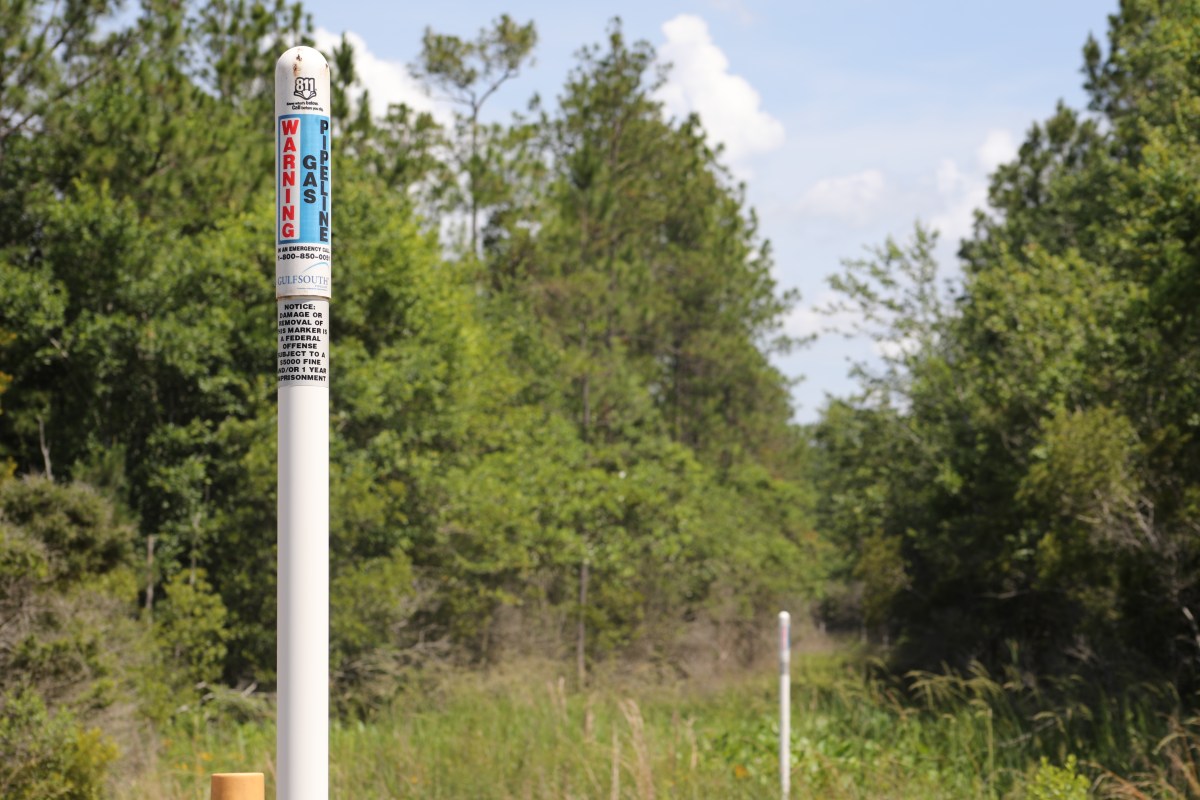
Emissions from leaky valves
The reason that Petal’s outsized methane emissions have persisted for so long—more than a decade after other gas companies and the EPA showed how they could be all but eliminated—might remain a mystery, but the source of the emissions is well-documented.
Geology is not to blame. Whether salt caverns or other rock formations are used, underground storage is highly effective at trapping natural gas under layers of impermeable rock that prevent the gas from escaping. A recent study found the daily volume of methane percolating through the soil near underground storage wells was 0.1 kilograms per day. That is less than the amount of methane that a cow burps in a 24-hour period.
However, at Petal, “reciprocating compressors,” which use pistons to pressurize natural gas for storage or to push gas through the regional pipeline network, were responsible for 99 percent of the 4,947 metric tons of methane that the facility released in 2020.
The vast majority of these emissions came from the compressors’ “isolation valves,” which disconnect the compressor from both the underground storage and the regional gas network when the compressor is not in use.
Compressors in a storage facility that provides natural gas to a region only during periods of peak demand can sit idle most of the year. This is the case with the Petal storage station, where the facility’s compressors sat idle for nine months on average in 2020.
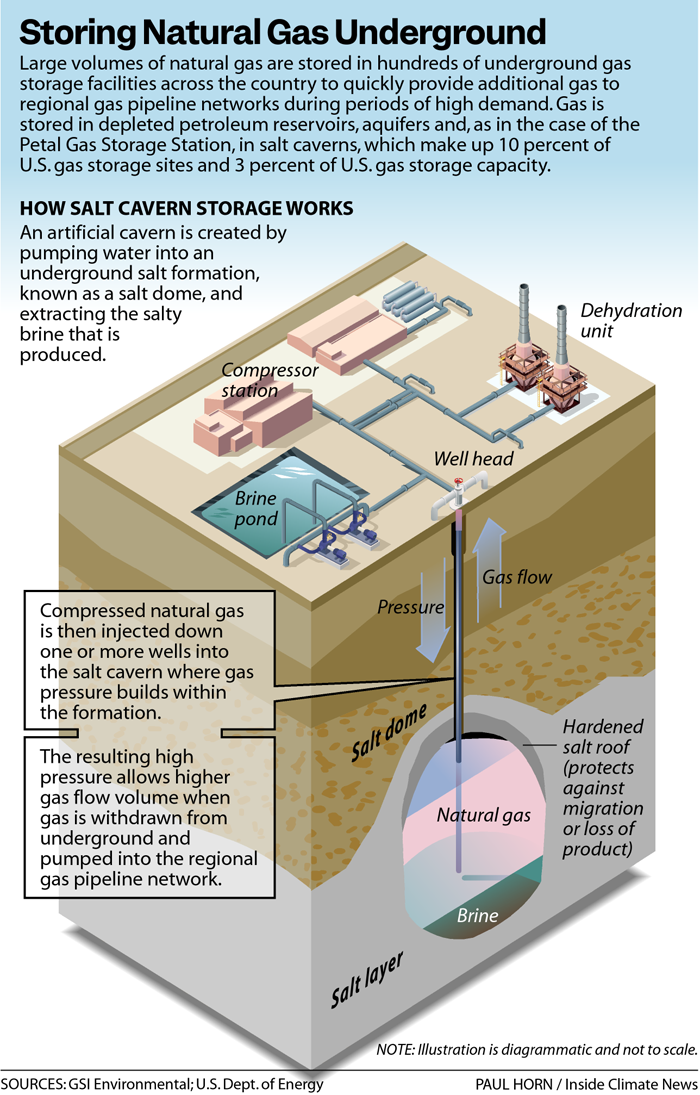
But Petal’s isolation valves are leaky. Instead of shutting off gas completely when closed, the isolation valves allow thousands of tons of methane to pass into the facility’s idled compressors. Once inside the compressors, the gas escapes into the atmosphere through open “blowdown valves.”
When Inside Climate News first inquired about the emissions from Petal in June 2021, Boardwalk Pipeline executives said the facility’s outsized emissions were a reflection of the site’s size and the role it played in the regional gas network. The Petal gas storage facility used a larger than usual number of compressors, not only to pump gas in and out of storage but also to push gas through the company’s transmission pipelines, they said.
“When the total emissions reported for this facility are broken out on a per compressor unit basis, they are comparable with other companies listed on the same EPA report,” Jillian Kirkconnell, a spokeswoman for Boardwalk Pipeline Partners said in a written statement.
But an analysis of emissions data from Petal by Inside Climate News found that the gas storage facility’s emissions in 2019 and 2020 were more than three times higher on a per compressor basis than the emissions rate from individual compressors averaged across each of the nation’s top 10 methane-emitting, underground gas storage facilities.
In fact, methane emissions from just one compressor at the Petal Gas Storage facility emitted more methane in 2020—2,355 metric tons— than the total methane emissions from any other gas storage facility in the United States that year.
Releases of such magnitude, Zimmerle said, typically cause frost to form on the outside of the leaking equipment as the pressurized gas escapes.
“You should see that if you’re at the site,” he said of the frost. “It should be pretty obvious to them.”
Zimmerle said he initially questioned the magnitude of emissions from the Petal facility, noting that individuals who make the measurements and report the data at any site sometimes accidentally add an extra zero, unintentionally inflating emissions. But after seeing that the company had elevated emissions year after year and recently acknowledged its high emissions and the efforts it has begun to reduce them, Zimmerle said, he changed his mind.
Boardwalk Pipelines did not dispute the data they reported to the EPA for 2020. In fact, in a sustainability report published last year, the company highlighted compressor emissions as a problem it is now working to address.
The company also did not dispute the conclusions reached by the Inside Climate News analysis, that emissions from the Petal facility are much higher on a per-compressor basis than other similar gas storage sites.
However, the company noted its 2021 reduction of methane releases from the Petal gas storage facility and that it reported these reductions to the EPA. Taylor Gillespie, a spokeswoman for the EPA, said the agency is still verifying emissions from 2021 that Boardwalk and other companies submitted earlier this year, and so could not verify the reductions.
Even if Boardwalk reduced emissions at the Petal facility as much as they claimed from 2020 to 2021, the plant’s methane emissions would still be 60 percent higher than any other underground gas storage site in the country, when compared to the most current emissions data available for other facilities.
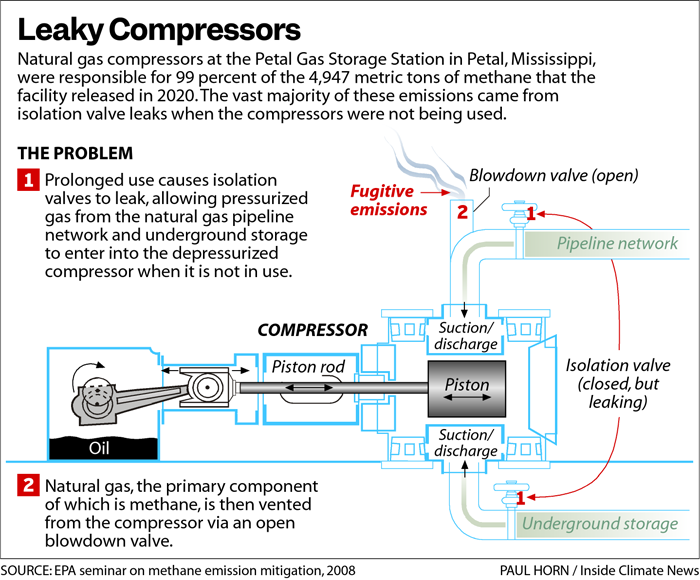
A ‘workable solution’ ignored
In the company’s first sustainability report, released last year, Boardwalk noted that it is modifying and replacing older compressor equipment to reduce methane emissions.
“Boardwalk is continuing to take steps to reduce emissions across its systems and compressor stations,” Kirkconnell said.
She added, “a number of compressor blowdown valves and isolation valves have been repaired or replaced and procedures at the facility have been modified to minimize methane losses when units are not in operation. This resulted in significant reductions in methane emissions from 2019 to 2020 to 2021.”
Climate advocates say the reductions are welcome news, but they add that it’s unclear why it took the company so long for those emissions reductions to begin.
The 2006 Gas STAR report emphasized as a “prudent operating practice” that operators should keep compressors pressurized when they are not in use, something the report states will reduce emissions by as much as 68 percent, at no cost, by eliminating isolation valve leaks. The report added that maintaining gas pressure on idle compressors can introduce additional safety concerns inside compressor buildings. But it also discussed precautions that could be taken to mitigate any added risk.
“There is no reason to believe it is not a workable solution,” said Zimmerle, of Colorado State University.
Zimmerle said there are a number of different strategies that compressor operators can pursue to reduce emissions. For example, gas company National Fuel recently reported 95 to 99 percent emissions reductions on two of its compressors by simply replacing leaky isolation valves with new ones.
Still, nearly two decades after the EPA-industry partnership’s report detailing its emission reduction strategies, Boardwalk and most other gas storage operators continue to depressurize their compressors, and report high emissions, when their compressors are not in use.
“It’s been over a decade since EPA published this report and there are still these significant emissions,” Lyons, the Environmental Defense Fund scientist, said.
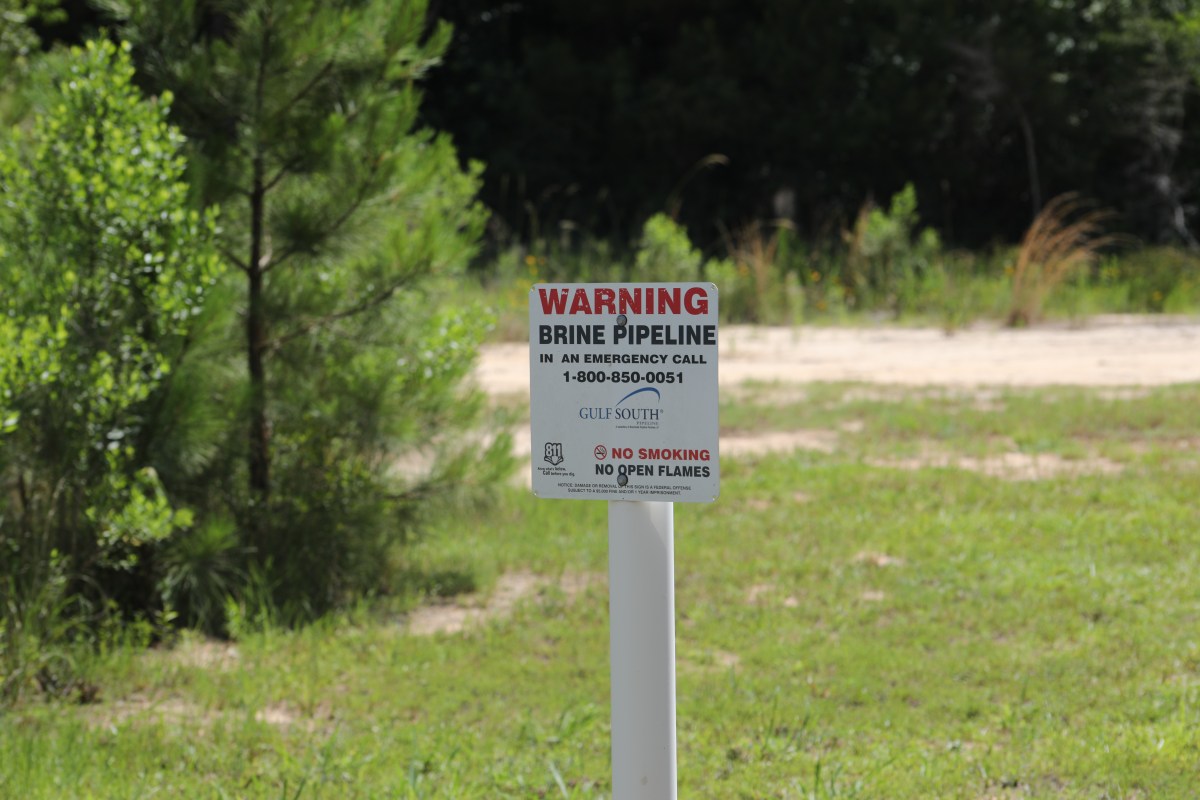
A proposed rule might make a difference
In its most recent annual financial report, filed to the U.S. Securities and Exchange Commission, Boardwalk noted that failing to reduce its emissions could pose a risk to its business.
“Increased attention to climate change, environmental, social and governance (ESG) matters and conservation measures may adversely impact our business,” the company wrote in the report. “Companies that do not adapt to or comply with investor or other stakeholder expectations and standards, which are evolving, or that are perceived to have not responded appropriately to the growing concern regarding ESG issues, regardless of whether there is a legal requirement to do so, may suffer from reputational damage and other adverse consequences.”
Boardwalk also noted that its emissions might soon be regulated under the EPA’s proposed rule to establish standards of performance for methane emissions from new and existing sources within the oil and gas sector, including gas transmission and storage. The agency is expected to issue a supplemental proposal containing proposed regulations “later this summer,” Joseph Goffman, the EPA’s principal deputy assistant administrator for the Office of Air and Radiation, said during a confirmation hearing last month. The agency expects to finalize the rule by the end of 2022.
“The proposed rule includes several requirements relevant to our operations, including stricter emissions limits for various facilities and equipment (including pneumatic controllers, storage tanks, reciprocating compressors, and wet seal centrifugal compressors), more frequent leak detection and monitoring of fugitive emissions from compressor stations, and deadlines for repairing fugitive emissions,” Boardwalk’s financial report stated.
Lyon, of the Environmental Defense Fund, said the rule will result in the reduction of methane emissions by an estimated 60,000 metric tons from reciprocating compressors—the same type of piston-driven compressors used at Petal facility—at gas storage facilities alone. When measuring the climate impact over a 20-year period, that’s equivalent to taking just over 1 million automobiles off the road.
Boardwalk noted in its sustainability report that it is an “active” member of the ONE Future Coalition, a group of natural gas companies working to voluntarily lower methane emissions across the natural gas supply chain. The group’s goal is to reduce methane emissions across the entire sector—from the wellheads of gas fields to the homes and businesses of end users—to less than 1 percent of total natural gas produced by 2025.
To align with this goal, Boardwalk will have to make significant additional cuts. Gas storage is a small subset of the gas industry and should make up a small fraction of the industry’s total emissions. However, in 2020 Petal alone leaked approximately 0.6 percent of the natural gas it stored that year—a rate equal to 60 percent of the entire industry’s targeted emissions budget—based on the emissions and storage data Boardwalk reported to EPA.
Danielle Fugere, the president and chief counsel for As You Sow, a non-profit shareholder advocacy organization, said the steps Boardwalk has taken in recent years are encouraging but that they still have a long way to go.
“You have to reduce your emissions to at least the level of other similarly situated companies, and even those companies need to do much more,” she said. “The first thing we would ask Boardwalk to do is to solve its compressor problems immediately, and then continue its work to reduce emissions year on year.”
This story was published in partnership with Inside Climate News, a nonprofit, nonpartisan news outlet that covers climate, energy and the environment. Click here for the Inside Climate newsletter.
This article first appeared on Mississippi Today and is republished here under a Creative Commons license.
Mississippi News
Events happening this weekend in Mississippi: April 18-20

SUMMARY: This weekend (April 18-20), Mississippi offers a variety of events for all ages. In Jackson, enjoy Food Truck Friday, a jazz concert, free outdoor movie screenings, and multiple exhibitions including “Of Salt and Spirit” and “Hurricane Katrina: Mississippi Remembers.” For family fun, there’s an Easter Egg Hunt at the Ag Museum and “Bunnies & Butterflies” at MCM. Natchez features the Spring Pilgrimage, Lafayette’s 200th anniversary celebration, and a farmers market. In the Pine Belt, highlights include Live at Five, a Spring Candle-Making Workshop, and Easter events at the Hattiesburg Zoo. Don’t miss the Bluff City Block Party and more!
The post Events happening this weekend in Mississippi: April 18-20 appeared first on www.wjtv.com
Mississippi News
Events happening this weekend in Mississippi: April 11-13

SUMMARY: This weekend in Mississippi (April 11-13), enjoy a variety of events across the state. Highlights include the Eudora Welty Birthday Bash in Jackson, Trivia Night at the Mississippi Museum of Natural Science, and Boots & Bling Fundraiser in Natchez. For family fun, check out the Bunny Bonanza in Jackson or the Easter Egg Hunt in Clinton. The Natchez Concours d’Elegance Car Show and Stranger Than Fiction Film Festival offer cultural experiences, while the 12th Annual Dragon Boat Regatta in Ridgeland and the Hub City Classic Car Show in Hattiesburg provide exciting activities for all ages.
The post Events happening this weekend in Mississippi: April 11-13 appeared first on www.wjtv.com
Mississippi News
Ole Miss women get pair of double-doubles and roll to 83-65 March Madness win over Ball State

SUMMARY: Mississippi coach Yolett McPhee-McCuin found solace in returning to a different arena in Waco, Texas, following a disappointing previous tournament experience. The No. 5 seed Ole Miss Rebels redeemed themselves with an 83-65 victory over 12th-seeded Ball State in the NCAA Tournament’s first round. Starr Jacobs led the Rebels with 18 points and 11 rebounds, while Kennedy Todd-Williams and Madison Scott each scored 15 points. Ole Miss dominated rebounding, leading 52-32, and will face fourth-seeded Baylor next. Coach McPhee-McCuin noted the team’s evolution since their last visit and the significance of playing in Texas, where Jacobs feels at home.
The post Ole Miss women get pair of double-doubles and roll to 83-65 March Madness win over Ball State appeared first on www.wjtv.com
-

 News from the South - Alabama News Feed6 days ago
News from the South - Alabama News Feed6 days agoFoley man wins Race to the Finish as Kyle Larson gets first win of 2025 Xfinity Series at Bristol
-

 News from the South - Alabama News Feed6 days ago
News from the South - Alabama News Feed6 days agoFederal appeals court upholds ruling against Alabama panhandling laws
-

 News from the South - Missouri News Feed3 days ago
News from the South - Missouri News Feed3 days agoDrivers brace for upcoming I-70 construction, slowdowns
-

 News from the South - North Carolina News Feed5 days ago
News from the South - North Carolina News Feed5 days agoFDA warns about fake Ozempic, how to spot it
-

 News from the South - Virginia News Feed4 days ago
News from the South - Virginia News Feed4 days agoLieutenant governor race heats up with early fundraising surge | Virginia
-

 News from the South - Missouri News Feed5 days ago
News from the South - Missouri News Feed5 days agoAbandoned property causing issues in Pine Lawn, neighbor demands action
-

 News from the South - Oklahoma News Feed3 days ago
News from the South - Oklahoma News Feed3 days agoThursday April 17, 2025 TIMELINE: Severe storms Friday
-

 Mississippi Today5 days ago
Mississippi Today5 days agoOn this day in 1947, Jackie Robinson broke MLB color barrier


































